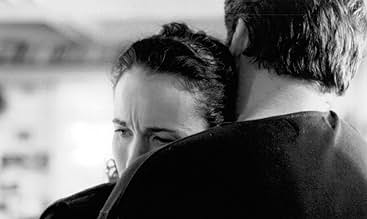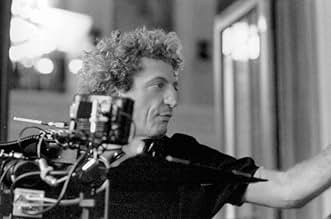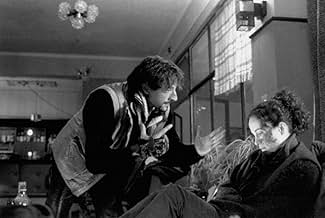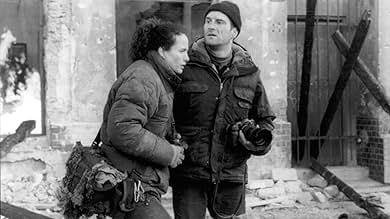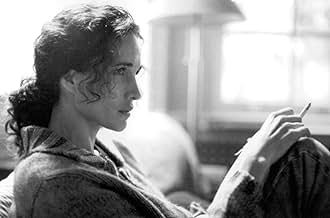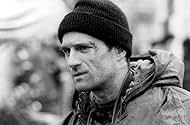Agrega una trama en tu idiomaWhen a Newsweek photojournalist disappears in war-torn Yugoslavia, his wife travels to Europe to find him.When a Newsweek photojournalist disappears in war-torn Yugoslavia, his wife travels to Europe to find him.When a Newsweek photojournalist disappears in war-torn Yugoslavia, his wife travels to Europe to find him.
- Dirección
- Guionistas
- Elenco
- Premios
- 3 premios ganados y 1 nominación en total
Scott Anton
- Cesar Lloyd
- (as Scott Michael Anton)
Opiniones destacadas
As someone who had lived through this war [I live in Osijek, town frequently mentioned in the movie, only 30 kilometers from Vukovar] and have seen the atrocities first hand, I'll start by commenting the realistic value. To my surprise, the Harrison flowers turned out to be very accurate in portraying what it was like. The details, such as locations, army uniforms and equipment, names, places, scenes and the geographic and historic facts, are pretty much all spot-on true. There are few barely noticeable mistakes, but it'd be nitpicking on my behalf even mentioning them. So, to anyone interested in seeing what the end 20th centuries warfare really looks like, I highly recommend it. It's miles ahead of Holywoods cheezy Rambo-style war movies and by it's ruthless realism it really is a visual kick in the gut.
As for the plot - the love story that serves as a guideline seems pretty much unnecessary and hard to believe. It has occurred to me that it'd be far more believable if Andie MacDowel was the photojournalist lost in the war-zone and her husband goes to get her out, not the other way around. So, those looking for a warm love tale, this will hardly be the best choice. Those interested in seeing the insanity of the easter-Europe 1991. war conflict, the cruelty and danger of modern photojournalism - I can hardly think of anything better than this.
As for the plot - the love story that serves as a guideline seems pretty much unnecessary and hard to believe. It has occurred to me that it'd be far more believable if Andie MacDowel was the photojournalist lost in the war-zone and her husband goes to get her out, not the other way around. So, those looking for a warm love tale, this will hardly be the best choice. Those interested in seeing the insanity of the easter-Europe 1991. war conflict, the cruelty and danger of modern photojournalism - I can hardly think of anything better than this.
I doubt very many will ever get to see Harrison's flowers. This is really the most misleadingly titled movie i can recall. The title and the fact that it stars Andie MacDowell reaks cuddly romantic girl movie. Nothing could be farther from the truth !
Instead this movie turns out to be one of the better warmovies i've seen in recent years.
The story is actually similar to that of "saving private ryan" and it's portrayal of war as griping and realistic. Only this time we're not put into the shoes of soldiers storming up a bulletsprayed beach but in the shoes of the civilians that cover the wars: the photojournalists. And the heroics is not killing the enemy but simply to bring the world a glimpse of what goes on inside a the chaotic inferno that is a warzone.
Andie MacDowell plays Sarah Lloyd a suberban mother of two and voted "most unlikely to be found inside a warzone" in her highschool yearbook. When her husband "Harrison" (a roughneck newsweek warphotographer) goes missing in wartorn Croatia 1991. She basicly picks up a camera herself and goes over there to find him. Rather unbelievable but it works well to set up the real story.
Instead this movie turns out to be one of the better warmovies i've seen in recent years.
The story is actually similar to that of "saving private ryan" and it's portrayal of war as griping and realistic. Only this time we're not put into the shoes of soldiers storming up a bulletsprayed beach but in the shoes of the civilians that cover the wars: the photojournalists. And the heroics is not killing the enemy but simply to bring the world a glimpse of what goes on inside a the chaotic inferno that is a warzone.
Andie MacDowell plays Sarah Lloyd a suberban mother of two and voted "most unlikely to be found inside a warzone" in her highschool yearbook. When her husband "Harrison" (a roughneck newsweek warphotographer) goes missing in wartorn Croatia 1991. She basicly picks up a camera herself and goes over there to find him. Rather unbelievable but it works well to set up the real story.
Harrison's Flowers is a journey into a journalist's personal hell. While some may feel that the premise of the story is rather lame and confabulated, it serves a purpose. To show the human side of the photo journalists who bring the horrors of the world to those of us who, as they noted in the movie, are just worried about getting a parking ticket.
Too often when we non-journalists see photos of war zones we are horrified and, at the same time, we are dumbfounded as to how someone could be so inhuman and unfeeling as to photograph such graphic examples of man's inhumanity to man. Harrison's Flowers is excellent at showing us that just as a reader we can't stop looking at the horror even though we are revolted, the journalist cannot stop photographing and documenting it even though the human side of them is revolted as well.
As for Andie MacDowell's so-called wooden performance, one must remember that in this film she is seeing her husband's and his colleagues' world through their eyes for the first time. How quickly would any of us be able to break out of our shock-like trance and be totally outraged or emotional if this were the first time we were seeing it? Even the veteran photo journalist portrayed by Brendan Gleeson was paralyzed with shock more than once in the film. Andie MacDowell's character came from such an insulated world that seemingly emotionless shock was the perfect way to portray Sarah, who simply cannot fathom what she sees unfolding around her.
Harrison's Flowers is an excellent portrayal of the Serbo-Croatian hell that descended upon that part of Europe and irreparably tore apart the life of anyone in its path.
Too often when we non-journalists see photos of war zones we are horrified and, at the same time, we are dumbfounded as to how someone could be so inhuman and unfeeling as to photograph such graphic examples of man's inhumanity to man. Harrison's Flowers is excellent at showing us that just as a reader we can't stop looking at the horror even though we are revolted, the journalist cannot stop photographing and documenting it even though the human side of them is revolted as well.
As for Andie MacDowell's so-called wooden performance, one must remember that in this film she is seeing her husband's and his colleagues' world through their eyes for the first time. How quickly would any of us be able to break out of our shock-like trance and be totally outraged or emotional if this were the first time we were seeing it? Even the veteran photo journalist portrayed by Brendan Gleeson was paralyzed with shock more than once in the film. Andie MacDowell's character came from such an insulated world that seemingly emotionless shock was the perfect way to portray Sarah, who simply cannot fathom what she sees unfolding around her.
Harrison's Flowers is an excellent portrayal of the Serbo-Croatian hell that descended upon that part of Europe and irreparably tore apart the life of anyone in its path.
An emotional film about a woman's search for her husband, shown through events that really happened in the Croatian city of Vukovar.
The city of Vukovar was destroyed by the JNA (Yugoslav People's Army) and Serb paramilitaries. Unfortunately, that really happened in 1991, and the hospital we see in the film really does exist, Serb paramilitaries pulled wounded Croatian civilians and soldiers out of it and killed most of them.
The massacre occurred shortly after Vukovar's capture by the JNA (Yugoslav People's Army ) and paramilitaries from neighboring Serbia. In that period, it was the fiercest battle in Europe since 1945, and Vukovar was the first major European city completely destroyed since World War II.
The film is really hard to watch, because the atrocities we see in the film, committed by Serbian paramilitaries and the JNA (Yugoslav People's Army), really happened in 1991.
The cast evoked the emotions and all the horrors of the war, the film is emotional, especially for those who survived the war.
The footage showing Serb paramilitaries entering the city and singing a truly disgusting song is faithfully reconstructed in the film and when you look at the actual footage from 1991, it is almost identical.
The cinematography is realistic and the directing is excellent. An emotional and impressive film.
The city of Vukovar was destroyed by the JNA (Yugoslav People's Army) and Serb paramilitaries. Unfortunately, that really happened in 1991, and the hospital we see in the film really does exist, Serb paramilitaries pulled wounded Croatian civilians and soldiers out of it and killed most of them.
The massacre occurred shortly after Vukovar's capture by the JNA (Yugoslav People's Army ) and paramilitaries from neighboring Serbia. In that period, it was the fiercest battle in Europe since 1945, and Vukovar was the first major European city completely destroyed since World War II.
The film is really hard to watch, because the atrocities we see in the film, committed by Serbian paramilitaries and the JNA (Yugoslav People's Army), really happened in 1991.
The cast evoked the emotions and all the horrors of the war, the film is emotional, especially for those who survived the war.
The footage showing Serb paramilitaries entering the city and singing a truly disgusting song is faithfully reconstructed in the film and when you look at the actual footage from 1991, it is almost identical.
The cinematography is realistic and the directing is excellent. An emotional and impressive film.
I just saw "Welcome to Sarajevo", a film that got a lot of press and positive remarks when it came out. I only suspect that much of the press was based on the fact that it came out only a couple of years after the end of that terrible war in Bosnia.
Just as in "Welcome" this film also depicts the life of journalists, trying to understand and convey the happenings in a country once believed to be almost western. (Which, I suspect, is the reason that it had such an impact on the western psyche.) As everbody else has pointed out this is where the best characters are found, especially Adrian Brodys character.
Several others have already pointed out that the main story revolving around a lost love and an heroic wife trying to save her husband is really awkward. But since you need somekind of story, that might just as well be it. I saw this film a second time just recently and actually managed to ignore the plot and focuse on the description of the madness that was eastern Croatia in the early 1990´s.
This film has an incredible feeling, the settings, the photography and the score makes it come really close to being in an actual war. I cant really praise this enough. Compared to "Welcome" this film hits you in the guts as it shows the brutality of urban warfare and the senseless killings that occur in all wars.
Other films about Bosnia that are recommended if you like this one, "No mans land", "Pretty Village, Pretty fire" and "Savior". And why not give "Welcome" a chance too.
Just as in "Welcome" this film also depicts the life of journalists, trying to understand and convey the happenings in a country once believed to be almost western. (Which, I suspect, is the reason that it had such an impact on the western psyche.) As everbody else has pointed out this is where the best characters are found, especially Adrian Brodys character.
Several others have already pointed out that the main story revolving around a lost love and an heroic wife trying to save her husband is really awkward. But since you need somekind of story, that might just as well be it. I saw this film a second time just recently and actually managed to ignore the plot and focuse on the description of the madness that was eastern Croatia in the early 1990´s.
This film has an incredible feeling, the settings, the photography and the score makes it come really close to being in an actual war. I cant really praise this enough. Compared to "Welcome" this film hits you in the guts as it shows the brutality of urban warfare and the senseless killings that occur in all wars.
Other films about Bosnia that are recommended if you like this one, "No mans land", "Pretty Village, Pretty fire" and "Savior". And why not give "Welcome" a chance too.
¿Sabías que…?
- TriviaCroatian city of Vukovar was defended by around 1,800 lightly armed soldiers of the Croatian National Guard (ZNG) and civilian volunteers, against as many as 36,000 JNA (Yugoslav People's Army) soldiers and Serb paramilitaries equipped with heavy artillery.
- ErroresDuring the battle, when they are hiding in the dead woman's house, the Serbian/Yugoslav tanks carry the Croatian national flag with a red star.
- Citas
Yeager Pollack: There are only two different types of people in this world. Those who have seen the war, and those who haven't.
- Versiones alternativasFor the United States version, the film's length was reduced by about 5 minutes; it also features a new score by Cliff Eidelman. All interview footage was cut. As well as a few short shots. The biggest cut is the one which announces the death of Cathy, the French journalist. The ending has a different voice-over. The only addition for the American version is when Sarah first says in the cafe "He's not dead".
- ConexionesReferenced in Film Geek (2005)
Selecciones populares
Inicia sesión para calificar y agrega a la lista de videos para obtener recomendaciones personalizadas
Detalles
- Fecha de lanzamiento
- Países de origen
- Sitios oficiales
- Idiomas
- También se conoce como
- Врятувати Харрісона
- Locaciones de filmación
- Productoras
- Ver más créditos de la compañía en IMDbPro
Taquilla
- Presupuesto
- USD 8,000,000 (estimado)
- Total en EE. UU. y Canadá
- USD 1,871,025
- Fin de semana de estreno en EE. UU. y Canadá
- USD 867,635
- 17 mar 2002
- Total a nivel mundial
- USD 3,033,646
- Tiempo de ejecución2 horas 10 minutos
- Color
- Mezcla de sonido
- Relación de aspecto
- 2.35 : 1
Contribuir a esta página
Sugiere una edición o agrega el contenido que falta

Principales brechas de datos
What is the Spanish language plot outline for Harrison's Flowers (2000)?
Responda

